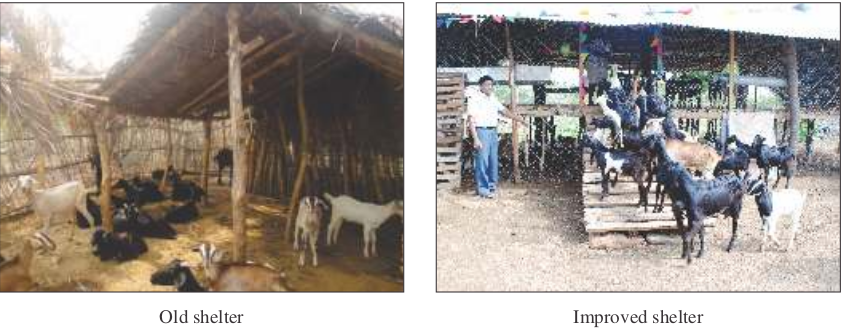स्नातक-पूर्व छात्रवृत्ति
स्नातक-पूर्व छात्रवृत्ति
Climate vulnerability
Heat stress and cyclone
Existing practice
Heat stress and rain storm are the foremost challenges that animals have to deal with for a period of 3-4 months in a year as these lead to disease epidemics in small ruminants. Further, high ambient temperatures outside the thermo - neutral zone cause significant changes in physiological processes including feed intake, production and reproduction. Continuous rain storms predispose the animals to infectious diseases. In general, majority of the farmers may not provide any shelter for small ruminants. Mostly tree shade is provided or the movement of animals during night is restricted by fencing the area with bamboo /wooden/iron material. As the animals are in contact with defecated fecal material, coccidiosis and tapeworm infestation are also common in herds. High temperature during April to August months and high intensity rainfall between September to November result in higher lamb and kid mortality due to heat stress and infectious diseases, respectively.
Resilient practice / technology
A semi-intensive system of rearing of goats in a slatted floor with proper roof can provide shelter to the animals to tackle heat stress during summer and rain storms during monsoon. Locally available wooden planks were used for making slatted floor. A gap of one inch was maintained between each slat so that the urine and fecal material could be collected from the bottom of the floor. The roof of the shelter was made with bamboo and covered with either thatched material or coarse cereal crop residues.
Impact
This model of a semi-intensive system of rearing of goats in a slatted floor was demonstrated in Vadhavathur village at Namakkal, Tamil Nadu. Due to the gap between the slats, collection of fecal material become easy and there was no accumulation of ammonia in the shed during rainy and winter season. The problem of spread of coccidiosis and tape worm infestation to healthy animals was controlled to a great extent. This resulted in decreased mortality from 10 to 2% and expenditure for treatment of affected animals was also avoided. The live weight gain of animals was enhanced from 60-70g to 78-86g per day as a result of protection from heat stress. This resulted in 3-4 kg more weight gain per animal at marketable age and resulted in additional income to the farmer by about Rs.500-700/animal.

Scope for upscaling
The practice of semi intensive system of rearing of small ruminants in a slatted floor with proper roof has a lot of potential in the coastal distracts of Kerala, Tamil Nadu, Karnataka, Andhra Pradesh, Odisha and West Bengal for providing sustainable livelihoods to farmers.
Source: Smart practices and Technologies for Climate Resilient Agriculture
